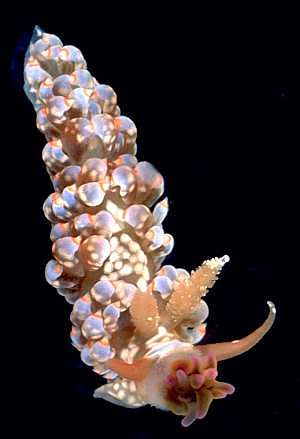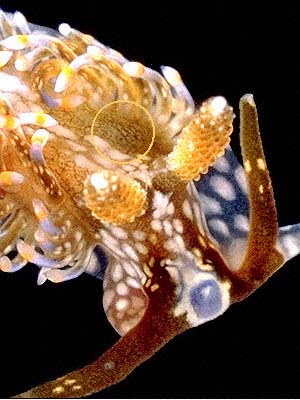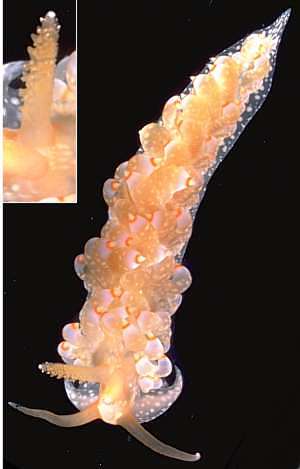
Spurilla australis
Rudman, 1982
Order: NUDIBRANCHIA
Suborder: AEOLIDINA
Family: Aeolidiidae
DISTRIBUTION
Probably found throughout Australia with records from South Australia, Western Australia, Queensland and New South Wales. Also found in northern New Zealand.
PHOTO
Upper Right: Dark colour form with half-swallowed sea anemone Cricophorus nutrix, in its mouth. Split Solitary Is, Coffs Harbour, NSW, February 1987.
Lower Right: Light colour form, Pilot Beach, Laurieton, NSW, November 1979.
Lower Left: Head of Spurilla australis showing the network of brown ducts (ringed) in which the zooxanthellae are "farmed". Pilot Beach, Laurieton, NSW, November 1979.
PHOTOS: Bill Rudman.
RELATED TOPIC
Spurilla australis is a member of the aeolid family Aeolidiidae, whose members all feed on sea anemones and related cnidarians. Its particular food is a small brown sea anemone Cricophorus nutrix which is usually found living attached to subtidal brown algae. Consequently, Spurilla australis is normally found crawling on or amongst brown algae. Sea anemones usually attach themselves firmly to a rock or other firm object with sticky secretions and the muscular actions of their "pedal disc" and are usually very hard to dislodge. Cricophorus nutrix however has evolved an escape behaviour. When disturbed it rapidly releases its hold and drops off the algae. This is a useful way of escaping from the attack of crawling predators such as nudibranchs. On a number of occasions I have watched Spurilla australis feeding on Cricophorus and it seems to have found a way of beating the anemone. As it approaches and "feels" the anemone with its long oral tentacles, it lines itself up with a tentacle on each side of the anemone then wraps the tentacles around the anemone so that as the anemone loosens its hold on the algae it is prevented from falling off. Spurilla then pulls the anemone to its mouth and engulfs it.
Some aeolidiids, including Spurilla australis and Berghia verrucicornis, feed on sea anemones which have single-celled plants (zooxanthellae) living in their bodies. This "living together" or symbiosis is quite common in cnidarians, the most well-known example being the reef-corals which could not produce their massive reefs without the assistance of the plants that grow in their tissues. When the aeolids eat the sea anemones they store the still living plants in special ducts connected to their digestive systems, where they are kept alive and "milked" of the sugars they produce when they photosynthesise. In the photo alongside of the head of Spurilla australis, the brown network pattern behind the head tentacles (rhinophores) are a network of ducts in the skin which contain brown zooxanthellae. This brown network penetrates the skin of all parts of the body which are open to sunlight. In this way the zooxanthellae are "farmed" in the best parts of the body for plant growth. For some reason some animals either lose their zooxanthellae or never retain any. Animals without any plants are very pale in colour, as in the animal on the right in the top photo.
Reference:
• Rudman, W.B. (1982) The taxonomy and biology of further aeolidacean and arminacean nudibranch molluscs with symbiotic zooxanthellae. Zoological Journal of the Linnean Society, 74: 147-196.


Rudman, W.B., 1999 (July 21) Spurilla australis Rudman, 1982. [In] Sea Slug Forum. Australian Museum, Sydney. Available from http://www.seaslugforum.net/factsheet/spuraust
Related messages
-
Re: Anemone capture by Spurilla major
From: David Mullins, October 14, 2008 -
Spurilla australis from Port Stephens
From: Leanne & David Atkinson, October 8, 2007 -
Spurilla australis from Lembeh Straits, Sulawesi
From: Matt Oldfield, March 26, 2007 -
Spurilla australis from Western
From: Bruce Potter, January 19, 2007 -
Spurilla australis from Victoria, Australia
From: Trevor McMurrich, August 22, 2006 -
Spurilla australis from Port Phillip Bay, Australia
From: Perry Davis, June 22, 2006 -
Spurilla australis from Northern New South Wales
From: Denis Riek, February 2, 2005 -
Spurilla australis from Western Australia
From: Mark Gerlach, February 20, 2004 -
Spurilla australis from Perth, Western Australia
From: Masoud Abadi, October 18, 2003 -
Nudibranch on Caulerpa taxifolia
From: Tim Glasby, August 18, 2003 -
Aeolidiopsis australis?
From: Nishina Masayoshi, August 6, 2002 -
Spurilla australis from Victoria
From: Jane Breidahl, January 9, 1999 -
Spurilla australis
From: Bill Rudman, July 2, 1998
